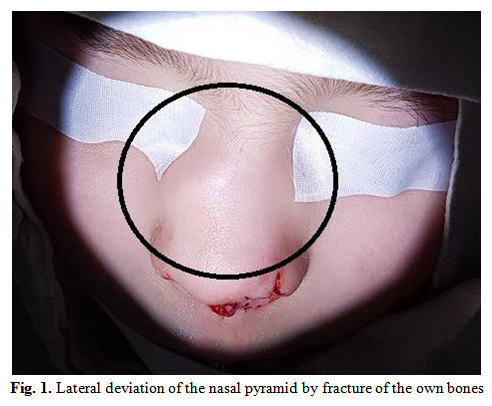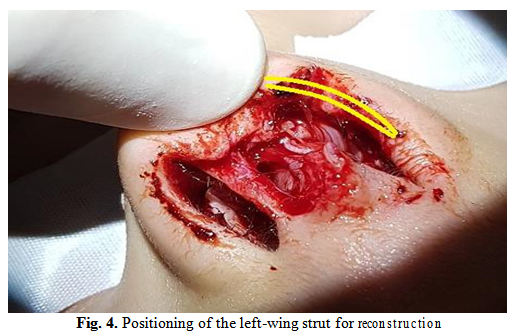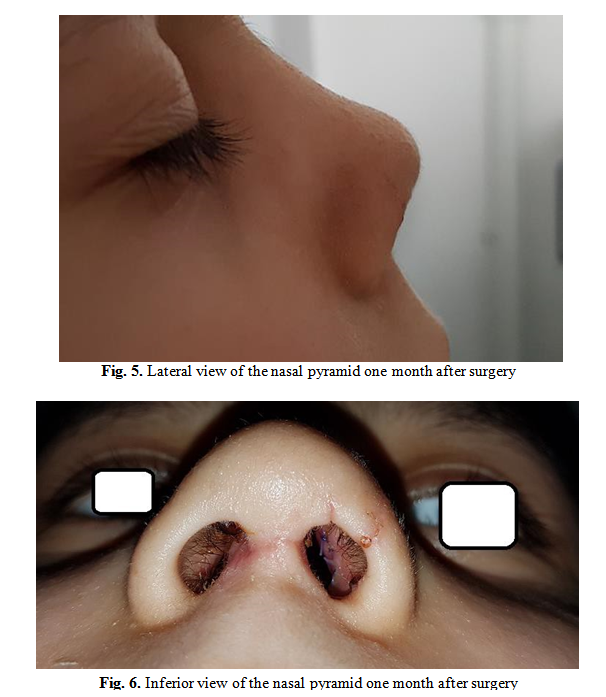Cranio-Facial Trauma in a 6-Year-Old – Esthetic and Functional Aspects

Abstract
Introduction
Both in adults and children cranio-facial traumas can have an important impact on the quality of life but for children the period for carrying the burden is much longer. Correct approach and solving of such cases bring esthetic and functional relief.
Material and method
We chose here to present the case o f a 6 years old boy who suffered an accidental injury of the facial skeleton by falling from a tractor. The results were fracture of the bony nasal vault, important hemorrhage, shock and multiple wounds of the nose skin. The surgical approach was done after stabilization, under general anesthesia and it tried to solve both the functional and esthetic part.
Results
As it can be seen from the photos the results were quite good especially from the functional point of view. Only by combining knowledge and approaches from both specialties the best results in regaining the normal quality of life can be achieved.
Conclusions
For the cases of facial trauma in children and considering the stages in development of the nasal bones, paranasal sinuses and neuro/viscero cranium the plastic and ENT aspect complete and never exclude each other.
Table of Contents:
1. Introduction
2. Material and method
3. Results
4. Conclusions
5. Discussions
1. Introduction
Facial trauma brings up in discussion two main aspects: the functional and esthetic one. Weather we are talking about car accident, playground accidents, blunt trauma, falling etcetera the functional part takes the first place. When involving children, the problem gets even worse as not solving entirely the problem brings up new issues regarding development of the facial skeleton, teeth and mandibular bone. At the same time growing up with various dysmorphic features of the face can lead also to psychological problems.
So, quality of life is the main goal in these situations but as these pathologies not always occur away from an emergency case sometimes the surgeon might find it difficult to combine all the goals [1, 2, 3].
2. Material and method
For this paper work we wish to bring into attention the case of a 6 years old male patient that suffered a cranio-facial trauma by accidental falling from a tractor seat directly with the nose in the ladder of the vehicle.
This led to massive epistaxis and shock, and open wound of the columela, a wound of the inferior nasal turbinates and fracture of the own bones of the nasal pyramid with lateral deviation [Fig. 1]. Also, a wound of the left nostril could be seen.

A complete list of the lesions also meant sectioning of the left alar cartilage, fracture and luxation of the septal cartilage and distruction of both crus mediale of the alar cartilages.
The goal of the intervention was set to stopping the bleeding, repositioning of the nasal bones and fixation of the fracture, redesigning the nose contours by suturing and reconstructing of the left nasal wing, gaining again the height of the nose and the function of the nasal valve.
3. Results
The intervention was done under general anesthesia as an emergency. Bleeding was stopped by using cautery and topical vasoconstrictive solution containing adrenalin.
As we are talking about a child repositioning of the nasal bones was done by simply pushing them on the opposite side.
For redefining the nasal tip and nasal valve we harvested cartilage from the nasal septum [Fig. 2] and obtained from it 3 struts: 2 for the columela [Fig. 3] and one for the left nasal wing [Fig. 4].


Sutures with 5-0 slow resorbable material kept the soft tissues in place. The fracture was stabilized by a metallic mask and adhesive bands on the outside and anterior nasal packing on the inside.
One-month postoperatory the results were very good both from the point of view of breathing and esthetic as shown in Figure 5 and 6.

4. Conclusions
When discussing any kind of trauma and transferring the focus to pediatric population the situation tends to become dramatic very quickly.
More than in other cases even bleeding can be fatal and if the case is not fully solved from the functional and esthetic point of view the quality of life decreases very much and can affect the whole development and future destiny of the child. Modifications of the facial skeleton that could become permanent will affect the development of the organs contained by the viscera and neurocranium.
In trauma cases emergency interventions are more desirable than conservatory approaches as the flexibility of the tissues is greater and the results could be better.
When working in a children hospital with ward from anesthesiology and pediatrician quick response to such cases is possible.
Once the bleeding is stopped basically the surgeon should perform a functional rhinoplasty in order to reconstruct the broken structures.
Care should be taken when suturing the wounds meaning respecting the tension lines of the tissues, using appropriate type of sutures and materials. If possible, one might only bring together the margins of the wound and not stitch it in some cases but just apply adhesive bandages. A course of 7 days antibiotics and anti-inflammatories is necessary usually.
5. Discussions
The main problem to be discussed in this sort of functional-plastic procedures that are usually performed for acute trauma in children is the follow up.
Cleaning the nose of a 6 years old patient can be a hard part for the physician but is o f high importance as it saves us from vicious healing meaning sinechia. This leads to incomplete or not enough functional results.
As important as it is the first step in this kind of surgery are also the rest.
When benefiting from general anesthesia after stopping the bleeding one should not stop and perform all the necessary steps to reach functional and esthetic amelioration.
However, if the work is not done by a well-prepared surgeon the results might be disastrous – vicious consolidation of the bones, keloid scars and airway impairment. [4, 5]
Contributo selezionato da Filodiritto tra quelli pubblicati nei Proceedings “National ENT, Head and Neck Surgery Conference - 2018”
Per acquistare i Proceedings clicca qui.
Contribution selected by Filodiritto among those published in the Proceedings “National ENT, Head and Neck Surgery Conference - 2018”
To buy the Proceedings click here.



